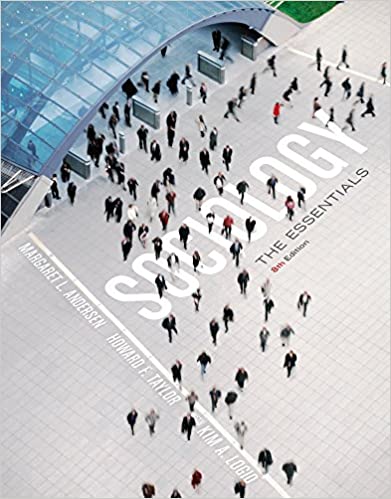
Sociology 8th Edition by Margaret Andersen ,Howard Taylor ,Kim Logio
Edition 8ISBN: 978-1285431321
Sociology 8th Edition by Margaret Andersen ,Howard Taylor ,Kim Logio
Edition 8ISBN: 978-1285431321 Exercise 2
Homeroom Security
Research Question: Random searches, zero-tolerance policies, metal detectors, surveillance cameras, security guards- the presence of these things in our public schools makes it seem as though the school system is a police state. What effect does such a strong security system have on today's students? Is this excessive discipline necessary and effective? These are the questions that drove sociologist Aaron Kupchik to study the climate of punishment in today's schools.
Research Method: Kupchik and his research assistants spent two years observing classrooms, hallways, and disciplinary meetings in four high schools located in two different states. In each state, two high schools were largely White and middle class; two, mostly poor with students predominantly from racial-ethnic minority backgrounds. In addition to participant observation, Kupchik interviewed 100 people, including students, parents, teachers, security staff, police, and administrators, and analyzed data from questionnaires that were given to all juniors in each of the four schools. This was a very comprehensive research design.
Research Results: Kupchik found that an atmosphere of punishment, not of learning, predominates in each of these schools and guides the interaction between students, faculty, and staff. Although poor, minority students are most likely subjected to such punishment, this climate also characterizes the treatment of White, middle-class schools. Students in each school perceived that the rules were unfair. The primary finding coming from this research is that the practices of punishment and discipline far outweigh the threat of actual wrongdoing. No doubt, Kupchik argues, high schools are sites of bullying, crime, and victimization, but the level of security in schools now is disproportionate to the actual risk of crime and wrongdoing
Conclusion and Implications: Ironically, Kupchik concludes that increased security and surveillance in schools actually increases student wrongdoing. Why? Because students will follow rules if they think they are fair, but will thwart them if they perceive the rules as unfair. Moreover, the fixation on rules and punishment overlooks the real problems students face-the context in which student wrongdoing actually emerges. With the priority given to punishment in schools, students' actual needs are not being met, and taxpayer dollars may not be used to greatest effect.
Questions to Consider
What kind of security was in place in the high school you attended? Was it effective? Did it decrease or increase misbehavior?
Research Question: Random searches, zero-tolerance policies, metal detectors, surveillance cameras, security guards- the presence of these things in our public schools makes it seem as though the school system is a police state. What effect does such a strong security system have on today's students? Is this excessive discipline necessary and effective? These are the questions that drove sociologist Aaron Kupchik to study the climate of punishment in today's schools.
Research Method: Kupchik and his research assistants spent two years observing classrooms, hallways, and disciplinary meetings in four high schools located in two different states. In each state, two high schools were largely White and middle class; two, mostly poor with students predominantly from racial-ethnic minority backgrounds. In addition to participant observation, Kupchik interviewed 100 people, including students, parents, teachers, security staff, police, and administrators, and analyzed data from questionnaires that were given to all juniors in each of the four schools. This was a very comprehensive research design.
Research Results: Kupchik found that an atmosphere of punishment, not of learning, predominates in each of these schools and guides the interaction between students, faculty, and staff. Although poor, minority students are most likely subjected to such punishment, this climate also characterizes the treatment of White, middle-class schools. Students in each school perceived that the rules were unfair. The primary finding coming from this research is that the practices of punishment and discipline far outweigh the threat of actual wrongdoing. No doubt, Kupchik argues, high schools are sites of bullying, crime, and victimization, but the level of security in schools now is disproportionate to the actual risk of crime and wrongdoing
Conclusion and Implications: Ironically, Kupchik concludes that increased security and surveillance in schools actually increases student wrongdoing. Why? Because students will follow rules if they think they are fair, but will thwart them if they perceive the rules as unfair. Moreover, the fixation on rules and punishment overlooks the real problems students face-the context in which student wrongdoing actually emerges. With the priority given to punishment in schools, students' actual needs are not being met, and taxpayer dollars may not be used to greatest effect.
Questions to Consider
What kind of security was in place in the high school you attended? Was it effective? Did it decrease or increase misbehavior?
Explanation
Sociologist AK has conducted a research ...
Sociology 8th Edition by Margaret Andersen ,Howard Taylor ,Kim Logio
Why don’t you like this exercise?
Other Minimum 8 character and maximum 255 character
Character 255


